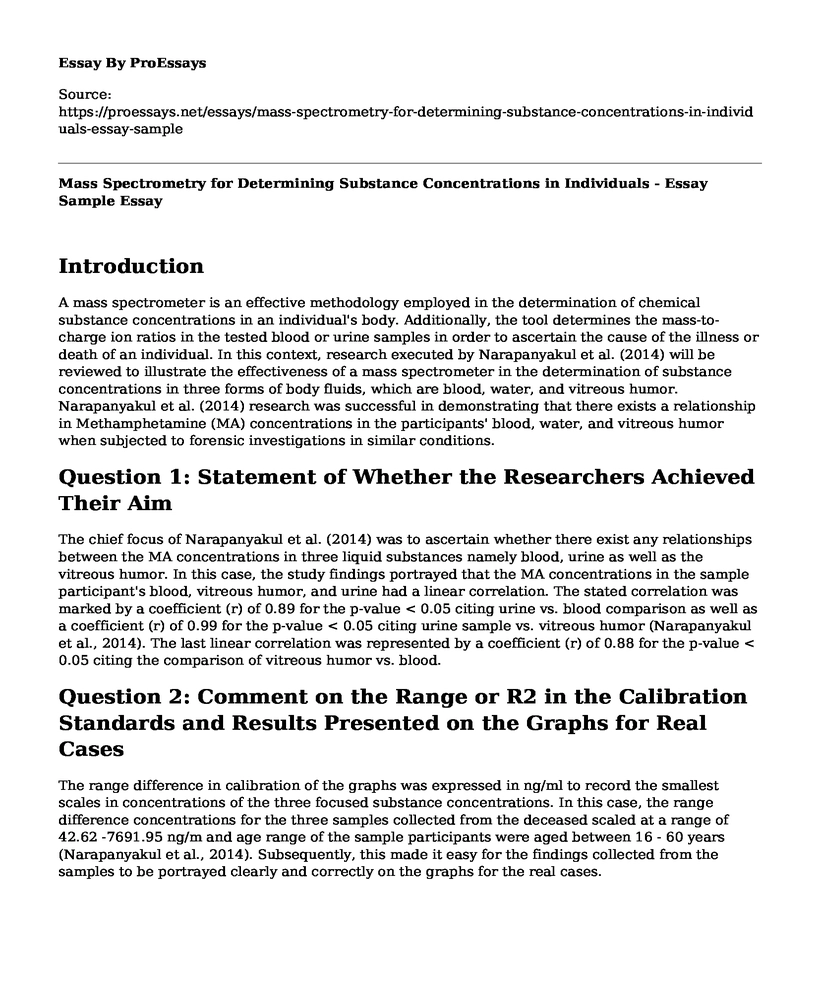Introduction
A mass spectrometer is an effective methodology employed in the determination of chemical substance concentrations in an individual's body. Additionally, the tool determines the mass-to-charge ion ratios in the tested blood or urine samples in order to ascertain the cause of the illness or death of an individual. In this context, research executed by Narapanyakul et al. (2014) will be reviewed to illustrate the effectiveness of a mass spectrometer in the determination of substance concentrations in three forms of body fluids, which are blood, water, and vitreous humor. Narapanyakul et al. (2014) research was successful in demonstrating that there exists a relationship in Methamphetamine (MA) concentrations in the participants' blood, water, and vitreous humor when subjected to forensic investigations in similar conditions.
Question 1: Statement of Whether the Researchers Achieved Their Aim
The chief focus of Narapanyakul et al. (2014) was to ascertain whether there exist any relationships between the MA concentrations in three liquid substances namely blood, urine as well as the vitreous humor. In this case, the study findings portrayed that the MA concentrations in the sample participant's blood, vitreous humor, and urine had a linear correlation. The stated correlation was marked by a coefficient (r) of 0.89 for the p-value < 0.05 citing urine vs. blood comparison as well as a coefficient (r) of 0.99 for the p-value < 0.05 citing urine sample vs. vitreous humor (Narapanyakul et al., 2014). The last linear correlation was represented by a coefficient (r) of 0.88 for the p-value < 0.05 citing the comparison of vitreous humor vs. blood.
Question 2: Comment on the Range or R2 in the Calibration Standards and Results Presented on the Graphs for Real Cases
The range difference in calibration of the graphs was expressed in ng/ml to record the smallest scales in concentrations of the three focused substance concentrations. In this case, the range difference concentrations for the three samples collected from the deceased scaled at a range of 42.62 -7691.95 ng/m and age range of the sample participants were aged between 16 - 60 years (Narapanyakul et al., 2014). Subsequently, this made it easy for the findings collected from the samples to be portrayed clearly and correctly on the graphs for the real cases.
Question 3: The Linearity of Figures Description
There is a similar relationship that can be manifested from Figures 3, 4 as well as 5 in Narapanyakul et al. (2014) research. In this case, it is evident that the regression analysis of the three graphs illustrate that they have a positive correlation coefficient. Also, the coefficients in the graphs are strong as the R-value in the three correlation graphs are near the value 1. Specifically, the R values in the three stated figures are R=0.89, R=0.99, and R=0.88 for Figures 3, 4, and 5 respectively (Narapanyakul et al., 2014).
Question 4: Comment on the Range and Significant Places in the Results
The evaluation of the ranges and 'significant' positions in the featured data set of nine samples of urine, blood as well as vitreous humor is positive. Additionally, this means that the accuracy of the regression analysis execute is accurate to provide an informed finding for the study.
Question 5: Comment on the Last Paragraph of the Conclusion
The last comment on Narapanyakul et al. (2014) research is right and accurate in reference to illustrating the similarities that exist between vitreous humor, blood, and urine in VA assessment. Furthermore, the Narapanyakul et al. (2014) researchers were right in stating the positive relationship of the three assessed substances is advantageous. Additionally, that is because vitreous humor can still be obtained from the back of cornea in a deceased person's eyes several days after his/her death. As such, the stated direct correlation would make vitreous humor would make an ideal alternative to blood or urine samples if the latter samples are unavailable or contaminated during forensic analysis.
Question 6: Position Statement If I Was a Member of the Grand Jury
If I was a member of the jury, I would accept the values that were reported for the MA after the analysis of the motorists' vitreous humor. Additionally, that is because the analysis of the three stated concentrations portrayed a direct linear correlation in all the three substances used in the analysis. As such, in the absence of urine or blood from the deceased motorist, I would accept the findings of the vitreous humor assessment in the case.
Conclusion
In conclusion, Narapanyakul et al. (2014) research was successful in demonstrating that there exists a relationship in MA concentrations in the participants' blood, water, and vitreous humor. Additionally, that is when such concentrations are subjected to forensic investigations in similar laboratory-controlled conditions. Moreover, the scientific revelation that there exists a direct linear correlation in the three stated concentrations is advantages. Additionally, that is because, during forensic investigations, vitreous humor can be used if blood and urine samples are inaccessible.
References
Narapanyakul, R., Tungtananuwat, W., Yongpanich, P., Sinchai, T., Thong-ra-ar, N., & Lawanprasert, S. (2014). Comparative study of postmortem blood, urine, and vitreous humor methamphetamine. The Thai Journal of Pharmaceutical Sciences, 38 (1), 5-13. Retrieved from https://www.researchgate.net/publication/261031241_Comparative_study_of_postmortem_blood_urine_and_vitreous_humor_methamphetamine
Zilg, B., Alkass, K., Berg, S., & Druid, H. (2016). Interpretation of postmortem vitreous concentrations of sodium and chloride. Forensic Science International, 263, 107-113. https://doi.org/10.1016/j.forsciint.2016.04.006
Cite this page
Mass Spectrometry for Determining Substance Concentrations in Individuals - Essay Sample. (2023, Jul 21). Retrieved from https://proessays.net/essays/mass-spectrometry-for-determining-substance-concentrations-in-individuals-essay-sample
If you are the original author of this essay and no longer wish to have it published on the ProEssays website, please click below to request its removal:
- Dark Energy
- Trigonometry Research Paper - Measuring the Height of Buildings
- Albert Einstein Biography - Essay Sample
- Paper Example on Qatar History
- Article Analysis Essay on Chemistry Current Event
- Essay Example on Centre of Mass & Centre of Gravity in Human Body
- Thomas Graham: Pioneering Chemistry through Graham's Law of Diffusion and Scientific Contributions - Free Paper







